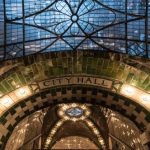 Technology
Technology  Technology
Technology  Our World
Our World 10 Ways Icelandic Culture Makes Other Countries Look Boring
 Misconceptions
Misconceptions 10 Common Misconceptions About the Victorian Era
 Mysteries
Mysteries 10 Strange Unexplained Mysteries of 2025
 Miscellaneous
Miscellaneous 10 of History’s Most Bell-Ringing Finishing Moves
 History
History 10 Great Escapes That Ended Right Back in Captivity
 Weird Stuff
Weird Stuff 10 Fascinating Things You Might Not Know About Spiders
 Food
Food 10 Everyday Foods You Didn’t Know Were Invented by the U.S. Military
 History
History 10 Odd Things Colonial Americans Kept at Home
 Weird Stuff
Weird Stuff 10 Superstitious Beliefs That Once Consumed Entire Cultures
 Technology
Technology 10 Scientific Breakthroughs of 2025 That’ll Change Everything
 Our World
Our World 10 Ways Icelandic Culture Makes Other Countries Look Boring
 Misconceptions
Misconceptions 10 Common Misconceptions About the Victorian Era
Who's Behind Listverse?

Jamie Frater
Head Editor
Jamie founded Listverse due to an insatiable desire to share fascinating, obscure, and bizarre facts. He has been a guest speaker on numerous national radio and television stations and is a five time published author.
More About Us Mysteries
Mysteries 10 Strange Unexplained Mysteries of 2025
 Miscellaneous
Miscellaneous 10 of History’s Most Bell-Ringing Finishing Moves
 History
History 10 Great Escapes That Ended Right Back in Captivity
 Weird Stuff
Weird Stuff 10 Fascinating Things You Might Not Know About Spiders
 Food
Food 10 Everyday Foods You Didn’t Know Were Invented by the U.S. Military
 History
History 10 Odd Things Colonial Americans Kept at Home
 Weird Stuff
Weird Stuff 10 Superstitious Beliefs That Once Consumed Entire Cultures
10 Iconic “Temporary” Structures That Still Stand Today
Some of the world’s most iconic structures were never meant to stick around. Built for the World’s Fairs, quick fixes, or temporary exhibitions, these buildings were supposed to be dismantled or demolished after serving their short-term purpose. But fate—and sometimes public opinion—had other plans.
Whether due to popularity, practicality, or sheer indifference, these “temporary” constructions ended up standing the test of time. Today, they’re landmarks, tourist attractions, and vital parts of their cities’ identities. From towering monuments to quirky oddities, here are ten famous structures that were meant to vanish—but never came down. In fact, they’re still standing strong.
Related: 10 Iconic Structures That Might Have Looked Radically Different
10 Flak Towers
During World War II, the Nazi government constructed eight anti-aircraft gun blockhouses across Germany and Austria. These “flak” towers were operated by the Luftwaffe to defend against Allied air raids, and also doubled as shelters for locals.
The thick concrete walls meant the towers could sustain large amounts of gunfire, which was great for wartime—but after the fighting ended in 1946, Germany was in no financial position to gather the materials to dismantle all of the flak towers. The tower near the Berlin Zoo was blown up in 1947 by the British. But the other towers stayed standing as the danger of accidentally harming the surrounding land or homes was too great.
As Germany leans away from its dark past, it has started to repurpose these huge buildings into more positive and peaceful icons of history. Some of the towers can be climbed and visited, one is a luxury hotel, and one is even an aquarium.[1]
9 Young Vic Theatre
Built for just 60,000 British pounds in 1970, the Young Vic Theatre in London was meant to be a temporary space for the National Theatre. Though it was meant to last just five years, the program to create accessible and affordable performances for teens and young adults was such a hit it still exists today.
What seemed like limitations at the time are now part of what makes the Young Vic so unique—tiny, black box theatres allow for a more intimate experience. The lack of funding from big sponsors meant the Young Vic could produce more bold and unknown shows with less famous actors.[2]
8 Palace of Fine Arts
Originally made of plaster and wood, the city of San Francisco had no intention of keeping its Palace of Fine Arts building up after the 1915 Panama-Pacific International Exposition.
What makes this building unique is that it wasn’t built to be a grand and opulent structure but to resemble a decaying ruin of ancient Rome. Architect Bernard Maybeck aimed to evoke a sense of historical beauty and serenity. It worked so well that a preservation team was formed to save the palace from demolition after the end of the exposition.
Though it began to actually decay in the 1960s, it was reinforced with more permanent building materials and has continued to bring peace and awe to visitors for over a century.[3]
7 Nashville Parthenon
Can you believe the Parthenon was built to be temporary? No, not the ancient Parthenon in Greece—the one in Nashville, Tennessee.
First, let’s talk about why there’s a full-scale replica of an Athenian temple in Tennessee. To celebrate 100 years of statehood in 1897, Tennessee hosted a centennial exposition. At the time, the state was known as the “Athens of the South” due to its emphasis on higher education. The city leaned into this comparison and created several replicas of Greek buildings, but the Parthenon was the only exact full-scale copy, making it the main attraction.
Because it was only meant to last the duration of the exposition, which was six months, by the 1920s, the new Parthenon was rapidly deteriorating. Major renovations were started and the building was reinforced with concrete. Today, it houses Nashville’s art museum—though, sadly, it focuses on 19th-and 20th-century paintings rather than ancient Greek statues.[4]
6 Atomium
One of the tallest structures in the small country of Belgium was never actually meant to become such an important part of the capital city.
The giant replica of an iron crystal cell sits on a hill in Brussels and has been there since the 1958 Brussels World’s Fair. The huge spheres contain museums and restaurants, and the tubes connecting them feature the longest escalator in Europe, and an elevator that allows you to look up at the sky as you shoot downward. It was only designed to last six months, but its popularity soon turned it into a city landmark. And in a city where the previous big attraction was a statue of a boy peeing… they wanted this Atomic Age building instead.
Many weren’t happy with the odd nature of the building, calling it hollow and ugly, while others called out the absurdity of building something to honor atomic energy less than a decade after the devastating nuclear bombings in Japan. Despite these worries, the Atomium was fitted with new lighting and renovations and still stands today.[5]
5 Montreal Biodome
The Montreal Biodome was built for the 1976 Olympic Games to serve as a cycling stadium. Housing both track cycling and judo events, the large glass dome could seat 2,600. Like all the other structures on this list, the Biodome was meant to stand for just the duration of the Olympics and then be dismantled. Unlike the other structures, the Biodome was not left standing because of the public’s love for it, but because of a mistake.
During construction, the workers welded the steel stresses together instead of just bolting them. It would be too expensive to destroy the entire building, so it was simply left where it was. In 1976, the iconic glass bubble was accidentally burned down, but the hard steel structure and lower building still remain today, serving as a natural ecological biosphere and museum.[6]
4 Museum of Science and Industry
When you think about the most famous buildings in Chicago, your mind probably goes to the iconic antennas of the Sears and John Hancock Towers or even the giant Ferris wheel on the Navy Pier. You probably won’t think of the Museum of Science and Industry, located on the city’s South Side—but perhaps you should.
The 1893 World’s Columbian Exposition put the Second City on the map. Over 200 neoclassical buildings were constructed around Chicago’s Jackson Park to dispel the idea that Chicago was a dirty city after the Great Fire in 1871. The Palace of Fine Arts, like all buildings built for the fair, was meant to be torn down after a few months. But even before the fair ended, the public couldn’t bear to have this gorgeous palace torn down.
Because it was built of brick instead of plaster like many other buildings, it was the perfect candidate to be turned into a permanent exhibit housing collections from the fair, and it still stands today. [7]
3 The Hollywood Sign
You may know that the huge white letters on Mount Lee used to spell out “Hollywoodland,” not just “Hollywood,” but did you know it wasn’t meant to last for years? Even crazier, it wasn’t erected to advertise the neighborhood in Los Angeles, but as temporary advertising for a local real estate development.
The “Hollywoodland” sign was dedicated in 1923. It was meant to stand for just under two years—but the rise of American cinema led to the Golden Age of Hollywood, and what better way to demonstrate the country’s opulence than this huge billboard?
Winds and dirt caused the sign to become damaged. In the 1940s, locals complained that it was “an eyesore and a detriment to the community.” The Hollywood Chamber of Commerce suggested removing the “Land” rather than the whole structure, in order to reflect the entire film district rather than just the housing development.[8]
2 London Eye
The City of London was looking for a way to open the new millennium in 2000, and what better way than to build a cantilevered observation wheel? No, not a Ferris wheel. Ferris wheels are supported on both sides, while the London Eye is only supported on one side.
Regardless of semantics, when the London Eye was opened to the public in 2000, the lease only allowed the structure to stand for five years. But after just one year, the world didn’t want to see it go. In addition to becoming an iconic tourist attraction and part of the skyline, the previously quiet neighborhoods of Waterloo and South Bank greatly benefitted from more foot traffic, leading to the popular decision to allow the wheel to remain far beyond its original five years.[9]
1 Eiffel Tower
It seems insane to think that Gustave Eiffel’s 1889 tower was almost torn down, but it seems even (at the time) the tallest structure in the world wasn’t safe from demolition. Built for the Paris World’s Fair, the Eiffel Tower was meant to be torn down and scrapped by 1909.
But of course Parisian city officials couldn’t bring themselves to tear down one of the most magnificent architectural wonders in history, right? Wrong. The only reason the building was allowed to stand is because its height made it ideal to be used as a radiotelegraph station. During World War I, the tower intercepted enemy radio communications, relayed Zeppelin alerts, and was used to dispatch emergency troop reinforcements.
Another close call came during the Second World War, when Hitler ordered the Eiffel Tower to be torn down as a symbol of his ultimate power. Luckily this never happened, and though it may have been useful for its height, it’s now recognized as a French icon simply for its beauty.[10]








